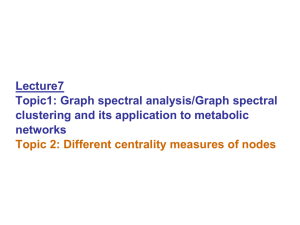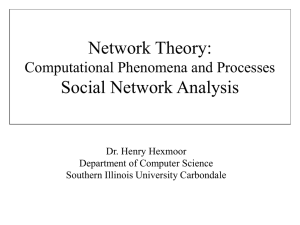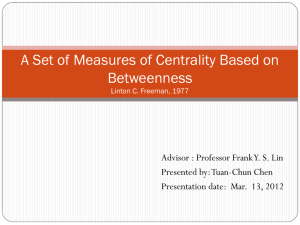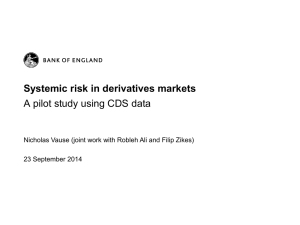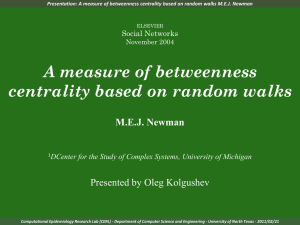Lecture 6
advertisement
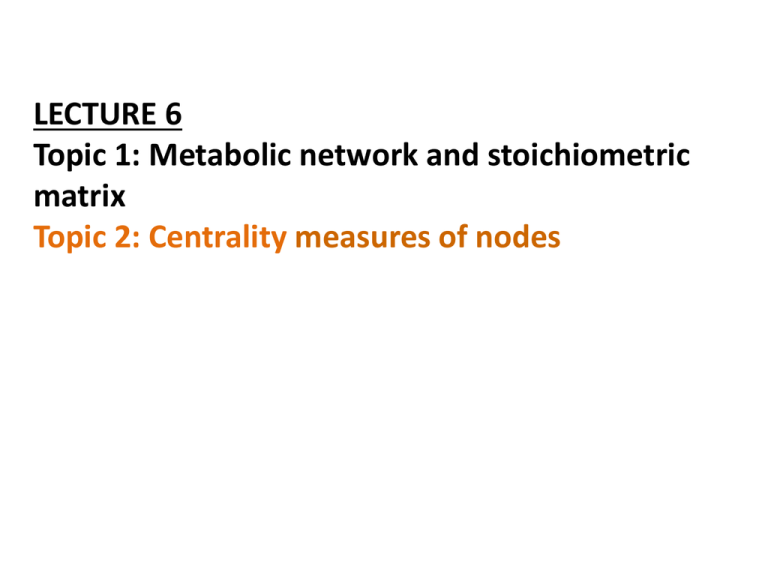
LECTURE 6 Topic 1: Metabolic network and stoichiometric matrix Topic 2: Centrality measures of nodes Typical network of metabolic pathways Reactions are catalyzed by enzymes. One enzyme molecule usually catalyzes thousands reactions per second (~102107) The pathway map may be considered as a static model of metabolism What is a stoichiometric matrix? For a metabolic network consisting of m substances and r reactions the system dynamics is described by systems equations. The stoichiometric coefficients nij assigned to the substance Si and the reaction vj can be combined into the so called stoichiometric matrix. Example reaction system and corresponding stoichiometric matrix There are 6 metabolites and 8 reactions in this example system stoichiometric matrix Binary form of N To determine the elementary topological properties, Stiochiometric matrix is also represented as a binary form using the following transformation nij’=0 if nij =0 nij’=1 if nij ≠0 Stiochiometric matrix is a sparse matrix Source: Systems biology by Bernhard O. Palsson Information contained in the stiochiometric matrix Stiochiometric matrix contains many information e.g. about the structure of metabolic network , possible set of steady state fluxes, unbranched reaction pathways etc. 2 simple information: •The number of non-zero entries in column i gives the number of compounds that participate in reaction i. •The number of non-zero entries in row j gives the number of reactions in which metabolite j participates. So from the stoicheometric matrix, connectivities of all the metabolites can be computed Information contained in the stiochiometric matrix Source: Systems biology by Bernhard O. Palsson There are relatively few metabolites (24 or so) that are highly connected while most of the metabolites participates in only a few reactions Information contained in the stiochiometric matrix In steady state we know that The right equality sign denotes a linear equation system for determining the rates v This equation has non trivial solution only for Rank N < r(the number of reactions) K is called kernel matrix if it satisfies NK=0 The kernel matrix K is not unique Information contained in the stiochiometric matrix The kernel matrix K of the stoichiometric matrix N that satisfies NK=0, contains (rRank N) basis vectors as columns Every possible set of steady state fluxes can be expressed as a linear combination of the columns of K Information contained in the stiochiometric matrix - And for steady state flux it holds that J = α1 .k1 + α2.k2 With α1= 1 and α2 = 1, v3 =-1 , i.e. at steady state v1 =2, v2 =-1 and That is v2 and v3 must be in opposite direction of v1 for the steady state corresponding to this kernel matrix which can be easily realized. Information contained in the stiochiometric matrix Reaction System Stoicheometric Matrix The stoicheomatric matrix comprises r=8 reactions and Rank =5 and thus the kernel matrix has 3 linearly independent columns. A possible solution is as follows: Information contained in the stiochiometric matrix Reaction System The entries in the last row of the kernel matrix is always zero. Hence in steady state the rate of reaction v8 must vanish. Information contained in the stiochiometric matrix If all basis vectors contain the same entries for a set of rows, this indicate an unbranched reaction path Reaction System The entries for v3 , v4 and v5 are equal for each column of the kernel matrix, therefore reaction v3 , v4 and v5 constitute an unbranched pathway . In steady state they must have equal rates Elementary flux modes and extreme pathways The definition of the term pathway in a metabolic network is not straightforward. A descriptive definition of a pathway is a set of subsequent reactions that are in each case linked by common metabolites Fluxmodes are possible direct routes from one external metabolite to another external metabolite. A flux mode is an elementary flux mode if it uses a minimal set of reactions and cannot be further decomposed. Elementary flux modes and extreme pathways Elementary flux modes and extreme pathways Extreme pathway is a concept similar to elementary flux mode The extreme pathways are a subset of elementary flux modes The difference between the two definitions is the representation of exchange fluxes. If the exchange fluxes are all irreversible the extreme pathways and elementary modes are equivalent If the exchange fluxes are all reversible there are more elementary flux modes than extreme pathways One study reported that in human blood cell there are 55 extreme pathways but 6180 elementary flux modes Elementary flux modes and extreme pathways Source: Systems biology by Bernhard O Palsson Elementary flux modes and extreme pathways Elementary flux modes and extreme pathways can be used to understand the range of metabolic pathways in a network, to test a set of enzymes for production of a desired product and to detect non redundant pathways, to reconstruct metabolism from annotated genome sequences and analyze the effect of enzyme deficiency, to reduce drug effects and to identify drug targets etc. Centrality measures of nodes Centrality measures Within graph theory and network analysis, there are various measures of the centrality of a vertex within a graph that determine the relative importance of a vertex within the graph. We will discuss on the following centrality measures: •Degree centrality •Betweenness centrality •Closeness centrality •Eigenvector centrality •Subgraph centrality Degree centrality Degree centrality is defined as the number of links incident upon a node i.e. the number of degree of the node Degree centrality is often interpreted in terms of the immediate risk of the node for catching whatever is flowing through the network (such as a virus, or some information). Degree centrality of the blue nodes are higher Betweenness centrality The vertex betweenness centrality BC(v) of a vertex v is defined as follows: Here σuw is the total number of shortest paths between node u and w and σuw(v) is number of shortest paths between node u and w that pass node v Vertices that occur on many shortest paths between other vertices have higher betweenness than those that do not. Betweenness centrality σuw a c d b f e Betweenness centrality of node c=6 Betweenness centrality of node a=0 σuw(v) σuw/σuw(v) (a,b) 1 0 0 (a,d) 1 1 1 (a,e) 1 1 1 (a,f) 1 1 1 (b,d) 1 1 1 (b,e) 1 1 1 (b,f) 1 1 1 (d,e) 1 0 0 (d,f) 1 0 0 (e,f) 1 0 0 Calculation for node c Betweenness centrality •Nodes of high betweenness centrality are important for transport. •If they are blocked, transport becomes less efficient and on the other hand if their capacity is improved transport becomes more efficient. •Using a similar concept edge betweenness is calculated. Hue (from red=0 to blue=max) shows the node betweenness. http://en.wikipedia.org/wiki/Between ness_centrality#betweenness Closeness centrality The farness of a vortex is the sum of the shortest-path distance from the vertex to any other vertex in the graph. The reciprocal of farness is the closeness centrality (CC). CC ( v ) 1 d (v, t ) t V \ v Here, d(v,t) is the shortest distance between vertex v and vertex t Closeness centrality can be viewed as the efficiency of a vertex in spreading information to all other vertices Eigenvector centrality Let A is the adjacency matrix of a graph and λ is the largest eigenvalue of A and x is the corresponding eigenvector then -----(1) N×N N×1 |A-λI|=0, where I is an identity matrix N×1 The ith component of the eigenvector x then gives the eigenvector centrality score of the ith node in the network. From (1) xi 1 N Ai , j x j j 1 •Therefore, for any node, the eigenvector centrality score be proportional to the sum of the scores of all nodes which are connected to it. •Consequently, a node has high value of EC either if it is connected to many other nodes or if it is connected to others that themselves have high EC Subgraph centrality the number of closed walks of length k starting and ending on vertex i in the network is given by the local spectral moments μ k (i), which are simply defined as the ith diagonal entry of the kth power of the adjacency matrix, A: Subgraph Centrality in Complex Networks, Physical Review E 71, 056103(2005) Closed walks can be trivial or nontrivial and are directly related to the subgraphs of the network. Subgraph centrality 01000000000000 10110100000000 01011100000000 01101101000000 00110100000000 01111010000000 M= 00000100001000 00010000100000 Muv = 1 if there is an edge between nodes u and v and 0 otherwise. 00000001010011 00000000101011 00000010010000 00000000000010 00000000110101 00000000110010 Adjacency matrix Subgraph centrality 10110100000000 04223211000000 12432311000000 12352310100000 03223211000000 12332501001000 M2 = 01111020010000 01101102010011 (M2)uv for uv represents the number of common neighbor of the nodes u and v. 00010000421122 local spectral moment 00000000110101 00000011240122 00000100102011 00000001221042 00000001221123 Subgraph centrality The subgraph centrality of the node i is given by Let λ be the main eigenvalue of the adjacency matrix A. It can be shown that Thus, the subgraph centrality of any vertex i is bounded above by Table 2. Summary of results of eight real-world complex networks.





